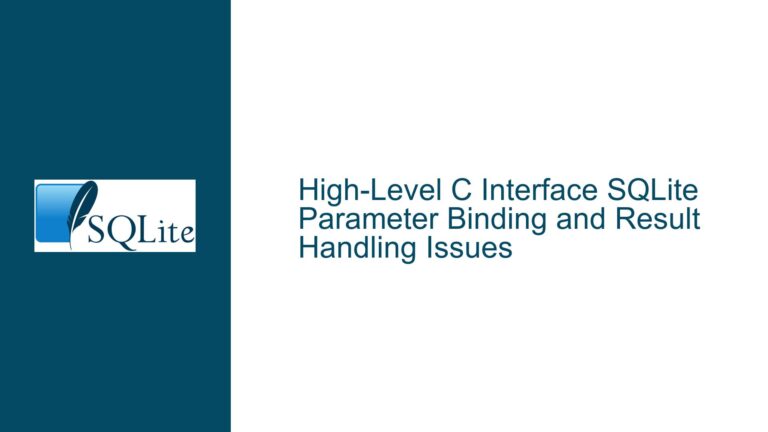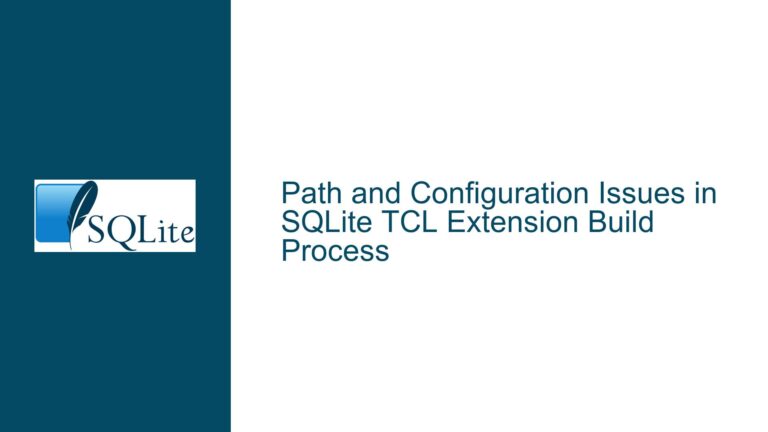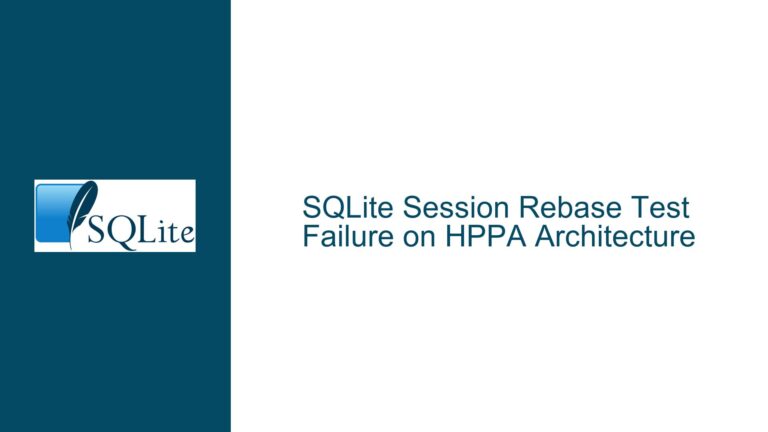Segmentation Fault in SQLite Prepared Statement Due to Heap Corruption
SQLite Segmentation Fault During Prepared Statement Execution
A segmentation fault occurring during the execution of a prepared statement in SQLite is often indicative of deeper underlying issues, particularly heap corruption. Heap corruption occurs when the memory allocator’s internal structures are overwritten or damaged, leading to unpredictable behavior, including segmentation faults. In this case, the segmentation fault manifests during the execution of a complex SQL query involving the domain_audit table, which is defined as follows:
CREATE TABLE domain_audit (
id INTEGER PRIMARY KEY AUTOINCREMENT,
domain TEXT UNIQUE NOT NULL,
date_added INTEGER NOT NULL DEFAULT (cast(strftime('%s', 'now') as int))
);
The query in question is a SELECT EXISTS statement that involves a subquery with a CASE expression and string manipulation functions. The backtrace from the segmentation fault points to memory allocation issues within SQLite, specifically during the execution of sqlite3MemMalloc and subsequent memory management functions. This suggests that SQLite is attempting to allocate memory for query execution but encounters corrupted heap structures, leading to a crash.
The segmentation fault is not necessarily caused by SQLite itself but rather by heap corruption that SQLite inadvertently encounters. This corruption could be the result of memory mismanagement elsewhere in the application, such as buffer overflows, use-after-free errors, or double-free errors. SQLite, being a heavy user of dynamic memory allocation, is often the first component to encounter such issues.
Heap Corruption from External Sources Affecting SQLite
Heap corruption is a common issue in applications that heavily rely on dynamic memory allocation. In this scenario, the corruption likely originates from outside SQLite, given that SQLite is a well-tested and robust library with extensive safeguards against internal memory corruption. The following are potential causes of heap corruption that could affect SQLite:
Memory Mismanagement in the Application: The application using SQLite, in this case, Pi-Hole’s FTL component, may have memory management issues such as buffer overflows, use-after-free errors, or double-free errors. These issues can corrupt the heap, causing SQLite to crash when it attempts to allocate or deallocate memory.
Concurrency Issues: If the application uses multiple threads to interact with SQLite, improper synchronization can lead to race conditions. For example, if one thread frees a memory block while another thread is still using it, heap corruption can occur. SQLite itself is thread-safe when used correctly, but the surrounding application code must also adhere to proper threading practices.
Third-Party Libraries: The application may depend on other libraries that manage memory independently. If these libraries have memory management bugs, they can corrupt the heap, affecting SQLite’s operations. For instance, a library might allocate a buffer that overlaps with memory used by SQLite, leading to corruption.
Compiler or Runtime Bugs: In rare cases, bugs in the compiler or runtime environment can cause heap corruption. For example, a bug in the memory allocator or the garbage collector (if applicable) could lead to memory corruption. This is less common but should not be ruled out entirely.
Hardware Issues: Faulty hardware, such as bad RAM, can cause memory corruption. While this is rare, it can lead to intermittent and difficult-to-diagnose issues. Running memory diagnostics can help rule out this possibility.
Diagnosing and Resolving Heap Corruption in SQLite Applications
To diagnose and resolve heap corruption issues affecting SQLite, follow these steps:
Step 1: Enable Memory Sanitizers
Compile the application with memory sanitizers such as -fsanitize=address or -fsanitize=memory. These tools can detect memory errors such as buffer overflows, use-after-free, and double-free errors. For example, using -fsanitize=address with GCC or Clang will instrument the code to detect memory issues at runtime:
gcc -fsanitize=address -o myapp myapp.c -lsqlite3
Running the application with these sanitizers enabled will provide detailed reports of memory errors, including the exact location in the code where the corruption occurs.
Step 2: Use Valgrind for Memory Analysis
Valgrind is a powerful tool for detecting memory management issues. Run the application under Valgrind to identify memory leaks, invalid memory accesses, and other heap-related problems:
valgrind --tool=memcheck --leak-check=full ./myapp
Valgrind will provide a detailed report of memory issues, including the call stack where the problem occurs. This can help pinpoint the source of heap corruption.
Step 3: Review Application Code for Memory Management Issues
Inspect the application code for common memory management mistakes. Pay particular attention to:
- Buffer Overflows: Ensure that all buffers are properly sized and that data written to them does not exceed their capacity.
- Use-After-Free Errors: Verify that memory is not accessed after it has been freed.
- Double-Free Errors: Ensure that memory is not freed more than once.
- Uninitialized Memory: Make sure all allocated memory is properly initialized before use.
Step 4: Check for Concurrency Issues
If the application uses multiple threads, ensure that all access to shared resources, including SQLite database handles, is properly synchronized. Use mutexes or other synchronization primitives to prevent race conditions.
Step 5: Isolate Third-Party Libraries
If the application uses third-party libraries, isolate them to determine if they are the source of heap corruption. This can be done by selectively disabling or replacing libraries and observing the behavior of the application.
Step 6: Test on Different Hardware
If hardware issues are suspected, run the application on different hardware to see if the problem persists. Additionally, run memory diagnostics to check for faulty RAM.
Step 7: Update SQLite and Compiler
Ensure that the application is using the latest version of SQLite and the compiler. Bugs in older versions of SQLite or the compiler could contribute to memory corruption issues.
Step 8: Implement Robust Error Handling
Add robust error handling to the application to catch and log memory-related errors. This can help identify issues that occur during normal operation and provide more context for debugging.
Step 9: Monitor Memory Usage
Use tools such as top, htop, or valgrind to monitor the application’s memory usage. Look for unusual patterns, such as memory leaks or excessive memory consumption, which could indicate underlying issues.
Step 10: Consult SQLite Documentation and Community
If the issue persists, consult the SQLite documentation and community for additional guidance. The SQLite mailing list and forums are valuable resources for troubleshooting complex issues.
By following these steps, you can systematically diagnose and resolve heap corruption issues affecting SQLite. While SQLite itself is unlikely to be the source of the problem, it often serves as a canary in the coal mine, highlighting memory management issues in the surrounding application code. Addressing these issues will not only resolve the segmentation fault but also improve the overall stability and reliability of the application.






